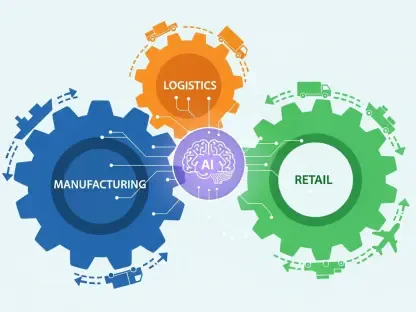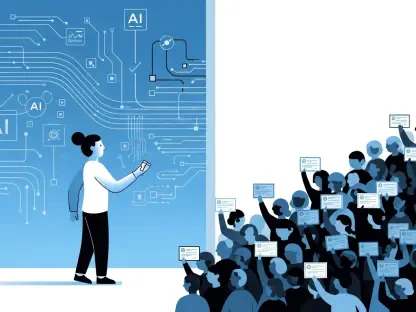The rise of artificial intelligence (AI) has introduced competitive dynamics across global industries, thrusting the U.S. into a race to maintain technological supremacy. Amidst diverse strategies, Hugging Face’s advocacy for open-source AI presents an intriguing path forward. Could this approach cultivate a more competitive, innovative, and inclusive AI landscape for America? With the incessant evolution in the AI landscape and the need to stay ahead, determining the most effective strategy is paramount for the U.S. to sustain its global leadership in technology.
The Appeal of Open-Source AI
Open-source AI models have demonstrated remarkable advancements, notably matching or surpassing proprietary models in performance and efficiency. Examples such as OlympicCoder and OLMo 2 illustrate that collaborative AI development can deliver superior outcomes at a fraction of the cost. The open-source framework leverages collective talent, allowing for a confluence of diverse ideas and technologies that can outpace the innovation capabilities of proprietary models. This collaborative nature sustains a dynamic environment conducive to rapid technological advancements.
The emphasis on open-source AI challenges the traditional preference for proprietary systems and underscores how transparency and collective input can drive rapid innovation. With open-source models, researchers and developers can freely access and contribute to projects, leading to a faster iteration of ideas and solutions. The transparency inherently associated with open-source platforms fosters trust and allows for comprehensive peer reviews, enhancing the robustness of AI models. This approach can tackle various challenges encountered in different sectors, potentially leading to groundbreaking solutions and applications.
Strategic Advantages for U.S. Competitiveness
Hugging Face’s proposal underscores how prioritizing open-source frameworks could sharpen America’s competitive edge. The company articulates that open research initiatives, supported by accessible datasets, can exponentially enhance the U.S.’s AI capabilities. By emphasizing open-source, the U.S. can harness the collective intelligence of a global talent pool, driving innovation at an unprecedented scale. This democratized approach ensures that innovations are not limited to a few entities but are widely accessible, thereby fostering a competitive spirit across the industry.
Central to this strategy is the establishment of the National AI Research Resource (NAIRR). This infrastructure aims to democratize access to essential AI tools and data, enabling diverse contributors to propel innovation across industries while reinforcing U.S. leadership in AI. NAIRR’s role in providing infrastructure and high-quality datasets is essential to level the playing field, ensuring that even smaller entities have the tools necessary to drive innovation. Hugging Face believes this framework can significantly bolster the U.S.’s position in the global AI landscape by fostering an inclusive environment where innovation thrives.
Economic and Inclusive Growth
Open-source AI strategies promote economic growth by lowering entry barriers for AI development. Smaller organizations, often sidelined by resource-intensive proprietary models, can now actively participate and innovate, fostering a more dynamic and diverse tech ecosystem. By mitigating the need for substantial capital investments, open-source models offer a more inclusive platform for a variety of players to contribute to and benefit from AI developments. This approach could significantly enhance innovation by tapping into a broader array of ideas and insights.
This inclusive growth model envisions widespread AI applicability, from small enterprises to large corporations, accelerating industry-wide advancement. As more entities leverage open-source AI’s capabilities, the overall economic impact could be profound, with far-reaching GDP multipliers. Enabling a broad spectrum of participants allows for the development of versatile applications that address specific industry needs, thereby driving substantial economic growth. Moreover, this inclusive model ensures that the benefits of AI advancements are more equitably distributed across different sectors of the economy.
Security and Transparency Considerations
A critical aspect of Hugging Face’s argument is the enhanced security through transparency that open-source AI offers. Transparent models allow for meticulous inspection and validation, ensuring safer adoption of AI technologies in sensitive domains. Unlike proprietary models, where the inner workings are often obscured, open-source solutions enable a thorough examination by a wide range of stakeholders. This transparency is pivotal in identifying and mitigating potential security risks, thereby fostering a safer AI ecosystem.
This perspective stands in contrast to the proprietary approach, which often relies on guarded secrecy. Open-weight models, safeguarded in secure environments, are posited as key to managing potential threats, establishing a robust security framework without compromising innovation. Hugging Face posits that a transparent development process encourages trust and continuous improvement, as vulnerabilities can be identified and addressed swiftly. This approach also ensures compliance with regulatory standards and promotes ethical AI development, a growing concern in the industry.
Diverging Perspectives within the Industry
The proposal from Hugging Face introduces a pivotal debate within the AI industry, highlighting a dichotomy between open and proprietary development models. While companies like OpenAI advocate for minimal regulation and competitive independence, Hugging Face sees collaborative frameworks as essential for sustainable advancement. This division underscores varying philosophies on how best to achieve technological and economic objectives in the highly competitive AI landscape.
This divergence reveals deeper policy considerations as the U.S. looks to enhance its AI programs. The question remains: which approach will best harness the technological and economic benefits while maintaining global leadership? Advocates for open-source models argue that collaborative efforts lead to rapid progress and inclusivity. On the other hand, proponents of proprietary models emphasize the need for competitive advantage and control over intellectual property. Balancing these perspectives will be crucial in formulating a cohesive AI strategy for the future.
Policy and Regulatory Implications
As the U.S. administration formulates its AI Action Plan, established under Executive Order 14179, the direction taken will significantly influence the nation’s AI trajectory. The decision-making process involves balancing minimal regulatory constraints with the potential benefits of an open, collaborative AI ecosystem. Policymakers must consider the economic, ethical, and social implications of different models while strategically positioning the U.S. as a global leader in AI.
Key policymakers must weigh the strategic implications of both approaches, considering factors such as economic growth, security, and sustainable innovation. The outcome will set a precedent for how the U.S. navigates the complex landscape of AI development and competition. Adopting a hybrid model that leverages the strengths of both open and proprietary systems might be a prudent approach. This balanced strategy could mitigate the risks associated with either extreme, ensuring robust, secure, and inclusive AI development.
Industry Dynamics and Future Outlook
The rise of artificial intelligence (AI) has injected competitive vigor across global industries, propelling the United States into a high-stakes race to retain its technological dominance. Among the myriad strategies being considered, Hugging Face’s support for open-source AI represents a particularly compelling direction. This method could potentially foster a more competitive, innovative, and inclusive AI environment in America. As AI technology continues to advance at a relentless pace, the imperative to choose the most effective strategy becomes even more crucial. For the U.S. to maintain its leadership on the global stage, evaluating the benefits of an open-source approach against other strategies is essential. This involves not only embracing innovation but also ensuring that AI development is accessible, equitable, and fosters collaboration across various sectors. Balancing these elements could be the key to sustaining American preeminence in the technological arena amidst the burgeoning AI revolution.









